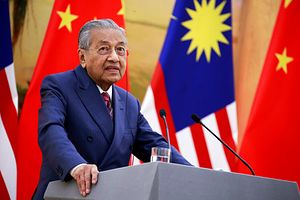On Monday, as expected, Malaysia’s parliament approved the country’s defense white paper following its introduction by the country’s defense minister. While the move came ahead of the document’s public unveiling, it nonetheless put the spotlight on a notable development within Malaysia’s defense policy under the new Pakatan Harapan (PH) government, despite the uncertainties that remain over its wider significance.
As I have noted before in these pages, one of the initial pledges made in defense policy by the new PH government after its shock ouster of the Barisan Nasional (BN) government in May 2018 was the release of the country’s first-ever comprehensive defense white paper. While questions have lingered about its process and prospects, if properly executed, the undertaking would represent a significant development for Malaysia’s defense policy and the new PH government in terms of clearly articulating a longer-term strategic defense vision, educating the public about security issues, and increasing transparency in the defense domain.
After some delay in the drafting process, Malaysian officials had suggested that the white paper would be introduced in parliament sometime in December, following the articulation of a key foreign policy document in September. The document would then be subsequently circulated publicly as well, in line with the initial commitment of fostering a more “whole of society” approach to defense policy.
On Monday, Malaysia’s defense white paper was in the spotlight with its circulation and subsequent approval by parliament. Malaysia’s Defense Minister Mohamad Sabu tabled the document in the legislature, where there was a discussion of the defense white paper before its adoption in parliament.
As expected, in his remarks to parliament, Mohamad touched on some of the key aspects of the defense white paper, including the state of the external environment with rising U.S.-China tensions as well as the government’s security priorities. He also mentioned some of the main threats and challenges facing Malaysia over the next few years, such as terrorism, tensions in the South China Sea, and cybersecurity.
Despite these revelations and the upcoming public release of the defense white paper, the nature of the parliamentary debate reinforced the fact that some specific questions remain unanswered and the future prospects of the document itself are unclear. Unsurprisingly, during the parliamentary discussions, several members of parliament, including former officials such as defense minister Hishammuddin Hussein, raised questions about the level of attention to specific issues, be it acquisitions or South China Sea policy, suggesting that the hierarchy of priorities and areas of focus remain unclear. Some of Mohamad’s comments also generated confusion, such as the suggestion, subsequently circulated in Malaysian media outlets, that Malaysia spend at least 1 percent of its GDP on defense, a level that would be far below what it needs and lower than the already-insufficient amounts allocated in previous years.
To a degree, the issues with respect to the defense white paper’s parliamentary introduction may have been expected given various factors at play, such the unprecedented nature of this interagency exercise for Malaysia; the country’s current contested political environment after recent local election setbacks for the PH government; uncertainties about the state of personnel and policymaking on defense issues, with concerns about conflicting statements on defense deals and countertrade; and the process of the document’s unveiling itself (including the fact that with the open parliamentary debate taking place without a public release of the document, the focus was on the defense minister’s performance and comments of members of parliament rather than the text itself, which was not made public). And while the quest for specificity is itself valuable, there is also the reality that this initial parliamentary conversation about the defense white paper cannot possibly address all questions to the level of detail necessary, especially with other steps forthcoming, including its public release and follow up documents in areas such as procurement and defense industry.
Nonetheless, the concerns raised during the parliamentary debate once again highlight the reality that while the very process of coming up with and releasing the defense white paper is itself notable for Malaysia, ultimately, its significance will be judged on what it says and how it fits into the actual conduct of Malaysia’s defense policy and its future security outlook, including how the government acts in areas such as budget allocations, alignments, and threat prioritizations amid wider challenges at home and abroad. Ultimately, as I have noted previously, the articulation of defense thinking in such documents is only one aspect of broader defense policy – which rests not just on what a government says, but how it actually acts. In that vein, how all of this plays out in Malaysia’s defense policy will be important to watch for the rest of 2019 and into 2020 as well.

































